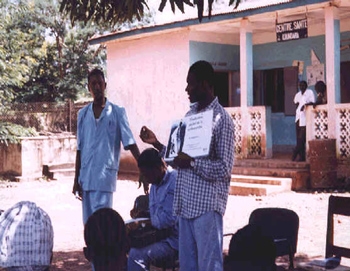 |
The Centers for Disease Control and Prevention (CDC) is a federal agency that exists both to protect the health of the populace and provide information about disease prevention and control. This agency was first created in 1946 in response to an outbreak of malaria, typhus and some other communicable diseases. It was initially called the Communicable Disease Center, but was later renamed the Centers for Disease Control and Prevention. Their headquarters is located in Atlanta, Georgia.
 |
The current director of the CDC is Dr. Jeffrey P. Koplan. He recieved his M.D. from Mount Sinai School of Medicine, and an MPH from Harvard University's School of Public Health. Dr. Koplan was involved in the eradication of smallpox during the 1970's, and lists that effort as one of the greatest triumphs in his career. His priority as director of the CDC is to "Rebuild the public health system so that we will be prepared for all of the health threats of the 21st century."
 |
The CDC has made an effort to eradicate many deadly diseases, and in some cases it has succeeded. In 1966 for example, the CDC initiated the Smallpox Eradication Program to eliminate smallpox, a disease that has killed millions through the centuries. The goal was reached in 1980, when the World Health Organization declared the eradication of smallpox.
The CDC is making an effort to inform the public with accurate information about Anthrax and other diseases in the news. They also provide information to clinicians about these diseases so they in turn can inform their patients. Also, the CDC has on their website a hoaxes and rumors section that falsifies information disseminated to scare the public. Travelers can refer to the CDC website to see if they should be aware of any health problems at their destination.
One area the CDC is currently involved with is the HIV/AIDS epidemic. The CDC has contributed in launching a global HIV/AIDS initiative called Leadership and Investment in Fighting an Epidemic (LIFE), which targets countries with the most severe HIV epidemics and where impact would be greatest.
The Epidemic Intelligence Service (EIS) is an organization within the CDC comprised of doctors, researchers and scientists who conduct surveillance for and respond to all types of epidemics. EIS was first established in 1951 to serve as an early warning system against biological warfare and man-made epidemics. Its founder, Alexander D. Langmuir, was first called out by the CDC to fight malaria.
The EIS is seen by some as the CIA of health care. EIS officers act as detectives that investigate epidemics, in the very broad sense. There are approximately 1,000 outbreaks of diseases each year in this country (colds, flu, hepatitis, etc.), and EIS is there to determine which ones are emergencies and acts accordingly.
 |
The CDC has helped to establish Field Epidemiology Training Programs in more than 20 countries. The Programs teach applied epidemiology, and has contributed in helping countries detect and contain disease outbreaks.
The world is constantly being monitored for potential epidemics as well. When outbreaks of disease occur overseas, such as the Asian flu in 1957-58, the EIS sets up a surveillance system to track the disease and also sets up vaccination plans for the public.
The EIS also responds to public health scares. In 1955 there was a polio vaccine scare that had many people nervous. The vaccine that was made to treat polio was actually getting some people sick. The EIS traced the vaccines that were causing this problem to one manufacturer, and restored public confidence in the polio vaccine.
The EIS is currently working on bioterrorism preparedness. Officers are being trained to recognize outbreaks caused by terrorists, and to respond to them.
Page created on 6/7/2004 12:57:58 PM
Last edited 7/18/2017 6:56:00 PM
